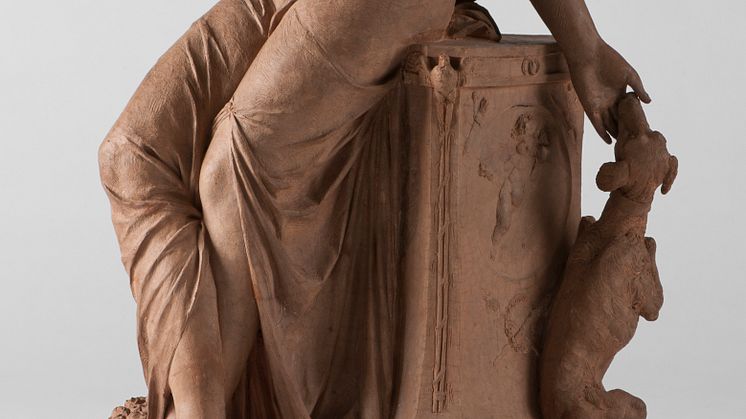
Press release -
New acquisition: Terracotta sculpture by Jean-Baptiste Stouf
Purchased by Nationalmuseum last year from a British art dealer, The Faithful Friendship is a rare work by the French sculptor Jean-Baptiste Stouf, exhibited at the Paris Salon in 1795. Stouf was a close friend of Johan Tobias Sergel during their student years in Rome more than two decades earlier. His work is a superb example of French neoclassicism, mixing classically inspired ideals of form with a romanticized cult of friendship.
Nationalmuseum has acquired a terracotta sculpture entitled The Faithful Friendship (La fidèle Amitié), created in 1795 by the French sculptor Jean-Baptiste Stouf (1742–1826) and exhibited at the Paris Salon that same year. The sculpture portrays a woman dressed à l’antique leaning against the altar of friendship and love, guarded by a dog, the symbol of fidelity. She is holding her right hand to her heart, while a dove, the symbol of love, has perched on her shoulder and crowned her with a wreath of flowers from a pomegranate tree, which represents marriage.
Although the motif reflects the French neoclassicists’ fondness for lofty subject matter, the work also has a narrative, literary aspect, with its many allusions to classical myths about lovers such as Hercules and Omphale, and Flora and Zephyr. In Stouf’s allegorical composition, the young woman is a symbol of friendship. Her sentimental, slightly dramatic pose, meanwhile, reinforces the generic nature of the piece, which is typical of the artist’s work at the time of the French Revolution.
The fine, graceful modelling of the woman’s skin in particular indicates that The Faithful Friendship should not be considered a prototype but rather a complete work in its own right. There are no other known versions. The phenomenon of finished terracotta was part of a new trend in the 18th century, when collectors were fascinated by the possibilities the material offered for artistic expression. This gave sculptors an opportunity to show off their creativity and technical skill on a smaller scale. Perhaps the best known creator of terracotta sculptures was Clodion, two of whose works are in Nationalmuseum’s collection. However, the museum’s terracotta collection is dominated by Sergel’s small sculptures, which have now been joined by The Faithful Friendship, by Sergel’s friend Stouf.
Further information
Magnus Olausson, Director of Collections and the Swedish Portrait Gallery, magnus.olausson@nationalmuseum.se, +46 8 5195 4371
Hanna Tottmar, press officer, hanna.tottmar@nationalmuseum.se, +46 8 5195 4390
Press images
www.nationalmuseum.se/pressroom
Nationalmuseum is Sweden’s premier museum of art and design. The collections comprise older paintings, sculpture, drawings and graphic art, and applied art and design up to the present day. The museum building is currently under renovation and scheduled to open again in 2017. In the meantime, the museum will continue its activities through collaborations, touring exhibitions and a temporary venue at the Royal Swedish Academy of Fine Arts, Fredsgatan 12, Stockholm. Nationalmuseum collaborates with Svenska Dagbladet, Fältman & Malmén and Grand Hôtel Stockholm. For more information visit www.nationalmuseum.se.
Categories

